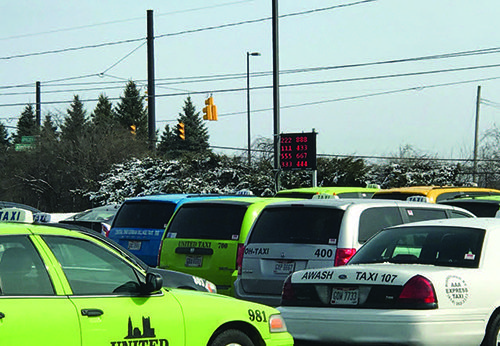A new $1 million ground transportation management system is dramatically reducing paperwork and helping John Glenn Columbus International Airport (CMH) more accurately account for fees paid by ride-share services and commercial operators that pick up and drop off passengers at the terminal. At the same time, the Ohio airport is enjoying more efficient and orderly taxi dispatching from the holding lot, which minimizes wait times for airport guests.
A new $1 million ground transportation management system is dramatically reducing paperwork and helping John Glenn Columbus International Airport (CMH) more accurately account for fees paid by ride-share services and commercial operators that pick up and drop off passengers at the terminal.
At the same time, the Ohio airport is enjoying more efficient and orderly taxi dispatching from the holding lot, which minimizes wait times for airport guests, reports Tracey Pomeroy, senior manager for parking and ground transportation at CMH.
The project cost about $1 million and was paid for with general airport revenue. The new system, from GateKeeper Systems Inc., took about six months to install and went online in March.
|
Project: New Ground Transportation Management System Location: John Glenn Columbus Int’l Airport (OH) Approx. Cost: $1 million Funding: General airport revenue Installation Timeline: Sept.-March 2019 2018 Airport Passenger Volume: 8.1 million Commercial Transportation Operators: 250+ System Vendor: GateKeeper Systems Inc. Technologies Employed: Geofences, transponders, radio frequency identification (RFID) RFID Technology Vendor: Transcore Electrical Contractor: Knight Electric Inc. Fiber Optics Contractor: Gudenkauf Corp. System Features: Onsite kiosk that allows taxi drivers to replenish their accounts for airport trip fees; digital signs that meter taxis from the holding lot one-by-one Key Benefits: Revenue tracking/verification for pick-up & drop-off fees; more efficient paperless processes; automated billing for commercial transportation companies; more orderly & effective taxi dispatching from holding lot |
Pomeroy explains that two primary factors drove the need for change: a sharp increase in ride-sharing services, such as Uber and Lyft, during the last several years; and cumbersome paperwork that bogged down everything from searching for report information to processing operating permits for taxis and other commercial operators.
Ride-sharing services posed an accountability problem because the vehicles are owned by individual contractors who aren’t responsible for paying the $4 pick-up and drop-off fees. As such, they didn’t mesh with CMH’s existing tracking system for taxis. Instead, the airport relied on ride-sharing companies to self-report the number of trips their drivers made into and out of the airport on a monthly basis, and the airport was unable to verify the numbers.
“We couldn’t determine if the reports we received from transportation network (ride-sharing) providers were accurate,” Pomeroy says.
“Nationwide, Uber and Lyft and others have taken significant amounts of passenger traffic from more traditional sources at airports,” adds Lynn Richardson, chief executive officer of GateKeeper. “As a result, airport curbsides don’t work as intended…at Columbus, there was a management system already in place to track taxi fees, but not for ride-sharing services.”
Ending the Paper Chase
Using a paper-based system slowed down administrative processes and made finding documents and getting them signed a time-consuming chore. “We needed to get rid of paper,” Pomeroy observes. “We wanted a digital database that could store pertinent information for commercial operators instead of using paper files—for things like their insurance forms, vehicle information and other documentation.
“We spent a lot of time shuffling papers around,” she continues. “Now, we can access everything right on a computer screen. GateKeeper hosts everything from all of our records to our taxi dispatch system to the taxi-driver payment kiosk, where drivers pay their pick-up and drop-off fees.”
 It used to take one employee anywhere from five days to two or three months to issue a single permit to a commercial transportation provider. Delays were caused by various circumstances, such as operators not including key information on forms, not signing all the necessary documents or submitting unnotarized documents, explains Pomeroy.
It used to take one employee anywhere from five days to two or three months to issue a single permit to a commercial transportation provider. Delays were caused by various circumstances, such as operators not including key information on forms, not signing all the necessary documents or submitting unnotarized documents, explains Pomeroy.
“We have about 250 commercial operators—limousine services, courtesy vehicles, buses and so forth—and the operators don’t always read directions carefully,” she says. But electronic forms make the process much faster and more efficient.
“Increases in volume at airports, especially at Columbus, have presented a need for better ways to manage ground transportation,” says Wendie Bidwell, a project manager at GateKeeper. “Most airports have very manual processes on the back end that require a lot of people to keep track of what’s going on. And there also are safety concerns: Airports need to know who’s on the property.”
A customer portal allows transportation companies to see their accounts with the airport and automates formerly time-consuming processes. For example, if a limousine company gets a new phone number, now it can submit an electronic change request.
“Then, all the airport has to do is approve it electronically, rather than take a phone call, write the new number down on a piece of paper and hand key it in later,” Richardson explains. “There’s also a financial module that automates the process of billing and collecting fees, either by credit card or by electronic payments.”
New Monitoring Capabilities
To track ride-share drivers, CMH established geofences—virtual geographic boundaries defined by GPS or radio frequency identification (RFID) technology.
The system ties into GPS technology on ride-share drivers’ cellphones to detect and log whenever their vehicles pass a geofence boundary. While the GateKeeper system doesn’t track the fees that ride-sharing companies owe each month, it gives CMH a record of how many times such vehicles enter and leave the airport.
“Hopefully, the numbers reported by the ride-share companies match what we see in the GateKeeper system in terms of arrivals and departures,” Pomeroy says. “If here’s a difference in the numbers, we can talk to ride-share providers and see if the geofences need to be adjusted.”
Overall, the system provides greater accountability and maximizes ride-sharing revenue, she says.
Taxis and other commercial transportation vehicles are tracked with RFID, similar to the system used by states to collect fees on tollways. The airport transponders are about the size of a credit card, and are applied to vehicle windshields like a sticker.
Antennas strategically located around the airport detect vehicles as they pass and record data such as the transponder number, time, the company that owns the vehicle and so on. Transcore supplied the antennas and transponders.
“Airports use that information to know who’s on the airport grounds and when,” says Richardson. “They also can check if vehicles comply with airport regulations (proper permits and car insurance, for instance) and, when necessary, track if there’s a charge owed for a trip to the airport.”
The system includes a kiosk in the taxi holding lot that allows drivers to “top up” the electronic accounts they use to pay pick-up and drop-off fees, which are withdrawn on a real-time basis.
 “One issue airports face is they have all kinds of people that owe them money,” Bidwell explains. “They might have to spend time chasing down Bob Smith Taxicabs, for instance, which owes a $50 fee at the end of the month. One way to avoid that is enabling drivers to pay on an automated basis by keeping a small balance in an account that can be replenished, either online or at a kiosk, whenever it gets low.”
“One issue airports face is they have all kinds of people that owe them money,” Bidwell explains. “They might have to spend time chasing down Bob Smith Taxicabs, for instance, which owes a $50 fee at the end of the month. One way to avoid that is enabling drivers to pay on an automated basis by keeping a small balance in an account that can be replenished, either online or at a kiosk, whenever it gets low.”
Better Taxi Dispatching
The GateKeeper system also improves taxi dispatching, notes Pomeroy. Previously, CMH used a buzzer system, with taxi drivers lining up in the holding lot until the taxi starter at the terminal pressed a button to “buzz” them.
“Then, a whole row of taxis would leave the lot and proceed to the terminal,” she says. “Chaos would ensue.”
Now, a large digital sign displays taxicab numbers to indicate when drivers may proceed to the terminal, one by one. The system uses RFID technology to determine the correct order to summon taxis, on a first-in, first-out basis.
“Taxi dispatching is much more orderly now,” Pomeroy reports. “And it’s more beneficial to airport guests because taxis are available at the terminal all the time. Before, if the starter was helping a customer, he might not access the buzzer as quickly to get more taxis to the terminal.”
Another benefit: Taxi starters now have more time to “walk the line” of taxi drivers and enforce certain guidelines—for instance, making sure drivers are dressed appropriately, not sleeping and not working on their cars as they wait. “Believe it or not, we’ve had taxi drivers with their hoods raised in line,” Pomeroy relates. “So the system is beneficial to both us and our customers, who get better taxi service.”

Maximizing Revenue
While it’s still too early to tell exactly how the GateKeeper system is impacting airport revenues, Pomeroy says there’s no doubt that ground transportation operations are running faster and smoother than before.

“Plus, we know we’re getting the revenue that we’re due,” she points out. “We just implemented drop-off fees earlier this year, and we probably wouldn’t have done that before because our old system wasn’t set up for it.”
“The system allows airports to be more accurate and collect all the fees they’re entitled to,” adds Richardson. “It also allows them to charge fees for things they couldn’t charge for before without an automated system.”
In addition, paperless processes enable ground transportation departments to focus more attention on customer service. “At Columbus, Tracey [Pomeroy] and her team are really utilizing technology to maximize efficiencies at their airport,” Bidwell says.


 facts&figures
facts&figures

